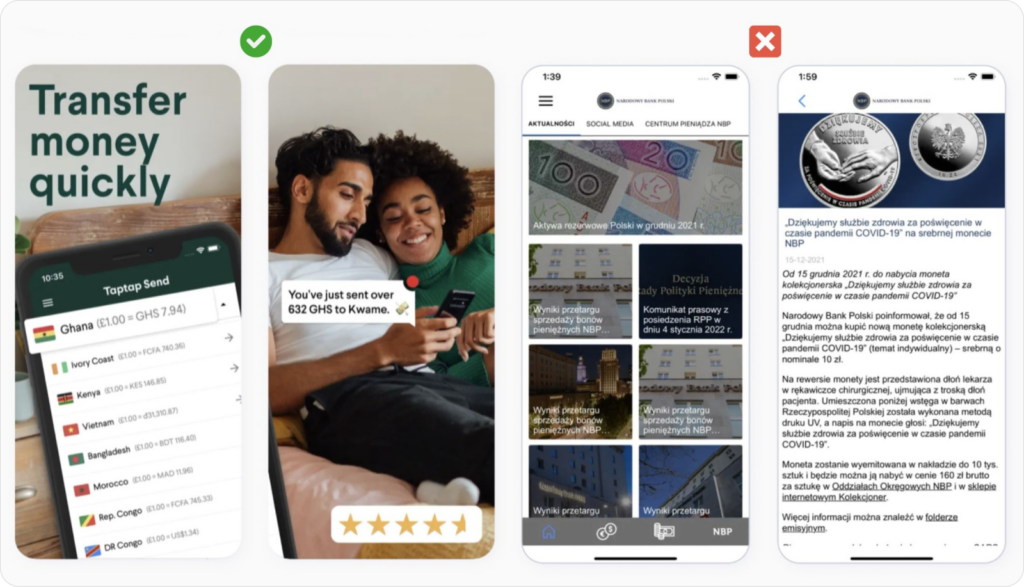- Ignoring App Quality While Craving Instant Success
- Wrong Keyword Optimization Strategy
- Don’t Let Your ASO Assets Be a Downfall
- Failing to Monitor and Analyze Performance
- Ignoring Emerging Trends
- Not Optimizing Your ASO Strategy
Experience is a great teacher, but an expensive one. This is why learning from the mistakes of others is such a valuable strategy. Their triumphs and failures offer useful lessons you can apply to your own goals, saving you time, resources, and even budget. The same principle applies to the world of app development and marketing. Understanding ASO mistakes can help pave the way for your app’s success.

Following this philosophy, in today’s article, we’ve collected the TOP common mistakes in ASO optimization that you should avoid in 2024. We classified these mistakes into two types: basic ones, which are common among newcomers to the field, and advanced ones, which experienced ASO marketers may encounter. Welcome to our article and become exceptional ASO specialists today!
Basic ASO Mistakes
Ignoring App Quality While Craving Instant Success
In general, what is ASO? It’s the art and science of optimizing your app listing elements – title, description, keywords, screenshots, and more – to improve visibility in app store search results and ultimately drive installs. More profound information about app optimization can be found in this special material.
Expecting immediate results. Some developers and marketers believe that once an app is published, their job is done. They expect users to flock in without any further effort. Consequently, they view ASO as unnecessary after the launch date. However, ASO is a long-term strategic process. It is not advisable to expect fast and impressive results after the first iteration of metadata. An application needs to gain a certain number of installs to occupy the top positions in the app stores.
The latest ASO trends show that the key to achieving long-term success is combining Brand Awareness + User Acquisition + ASO + Retention. This dedicated approach will ultimately help you achieve your desired return on investment and position your app for sustained success.
Neglecting the Quality Connection. But there is also a downside: if you have been doing ASO for many months and still can’t find any results, maybe your app is holding you back. A successful ASO strategy goes hand-in-hand with a high-quality app. Users who download an app based solely on an enticing listing but encounter a low-quality app with bugs, poor UI, or limited functionalities are unlikely to stick around. Therefore, ASO complements a great app, not the other way around.
Invest in creating a high-quality app that delivers on its promises to ensure users have a positive experience and are more likely to convert and leave positive reviews, further boosting your app’s discoverability through ASO. Remember, a good app combined with an effective ASO creates a powerful synergy that drives sustainable success.
The All-or-Nothing Approach. Implementing all ASO changes simultaneously can be overwhelming and counterproductive. Instead, we recommend that you introduce transformations one by one so you can monitor them individually. Why is it so important? Let’s imagine text and graphical elements were updated concurrently. Quality text optimization will boost impressions, for the app will be indexed for more keywords. On the other hand, this may lead to a decrease in conversions into installs as the app gains visibility with a wider audience and shows up more frequently in searches. In this case, it’s impossible to unambiguously evaluate the performance of graphical improvements. Such a method could work for applications with high traffic flows.
Thus, for most apps, it is beneficial to introduce ASO changes gradually to monitor their impact individually. This allows for a more controlled and accurate analysis of the impact of each change. This approach helps developers understand which changes are truly driving improvements in app store visibility and organic downloads.
Wrong Keyword Optimization Strategy
Keywords are the search terms users enter in app stores, and they play a crucial role in how easily users can discover your app. Choosing the right keywords is vital for effective App Store Optimization (ASO). Studying the mistakes of others can help you avoid common problems and ensure your app stands out in search results.
Not Prioritizing Keyword Research. Skipping keyword research means missing out on understanding the specific terms users are searching for related to your app. You need to understand what users are searching for and the keywords your competitors are targeting to effectively reach your target audience.
By the way, don’t forget that you can check your app indexation for keywords completely for free using the Keyapp platform. There are no limitations on the number of requests or countries you can work with.
Keyword Stuffing. Cramming your app title, description, and other fields with excessive keywords unnaturally can hurt your ranking. App stores penalize keyword stuffing, and it creates a confusing experience for users who don’t find what they’re looking for. Focus on using relevant keywords organically and strategically throughout your app store content.
Irrelevant Keywords. Including keywords that are not related to your app’s functionalities or target audience can negatively impact conversion rates. Don’t try to be everything to everyone. Choose keywords that are highly relevant to your app’s functionalities and target the specific needs of your ideal users. Stick to keywords that accurately describe your app and what it offers. If you are interested in finding relevant keywords with high search volume and low competition, then we recommend checking out our video on this topic.
Using Copyright, Stop, and Trademark Words. Including copyrighted terms, stop words, or trademarks within your app store listing can trigger app store rejection. Ensure your chosen keywords are appropriate and don’t infringe on intellectual property rights.
Not Localizing Keywords. In today’s global app market, neglecting to localize your keywords for different regions can significantly limit your app’s reach. If you want to reach users worldwide, consider translating your keywords and adapting them to local search trends and cultural nuances.
Remember, effective keyword optimization requires a strategic approach that goes beyond simply including as many keywords as possible. Focus on using relevant, targeted keywords to ensure your app gets discovered by the right users.
Don’t Let Your ASO Assets Be a Downfall
In the realm of app stores, where users quickly make decisions based on initial impressions, your app’s visual elements are crucial for attracting downloads. However, creating effective visuals goes beyond simple aesthetics. Some common mistakes in optimizing these assets can significantly hinder your ASO efforts.
Low-Quality Screenshots and App Previews. Users rely heavily on screenshots and app previews to understand an app’s functionalities and user interface. Using blurry, generic, or poorly designed visuals fails to showcase your app’s value proposition effectively. Invest in creating clear, engaging screenshots that highlight key features, user interactions, and the overall app experience. Similarly, develop app previews that offer a dynamic glimpse into your app’s functionality, showcasing how it solves user problems or provides value.

No Response To Reviews. Don’t ignore customer reviews or respond with generic phrases. Users evaluate apps based on developer responses, so it’s important to show active support and effective problem-solving. Provide detailed solutions, especially for negative reviews or low ratings, and encourage users to update their reviews after addressing the underlying issue. By the way, Google Play indexes both user reviews and developer responses. When writing a response, try to include relevant keywords while ensuring that your response remains clear and understandable to users.
Not Considering Video Previews. Well-crafted video previews can provide a more immersive experience compared to static screenshots. This allows you to showcase app features in action, demonstrate its ease of use, and highlight the benefits users can expect. While video previews may require more resources to create, neglecting them can put you at a disadvantage compared to competitors who utilize this powerful storytelling tool.
Therefore, prioritizing high-quality visuals, embracing A/B testing, and considering the potential of video previews can optimize your app store assets to effectively represent your app’s value and attract more engaged users. Keep in mind: first impressions matter and your app’s visuals are your chance to make a positive one.
Advanced ASO Mistakes
Failing to Monitor and Analyze Performance
Just like any investment, an effective ASO requires a data-driven approach. This means regularly monitoring key performance metrics and analyzing the insights to identify opportunities for improvement. Although, many app developers and marketers fall into the trap of neglecting this essential process, hindering their app’s potential.
Avoiding the Importance of Numbers. Failing to track key metrics like app store ranking, organic downloads, install conversion rates, and user acquisition costs creates a blind spot in your ASO strategy. These metrics offer valuable insights into how users are finding your app, how effective your ASO efforts are in driving downloads, and the overall cost of acquiring new users. Without this data, you’re essentially managing your ASO strategy in the dark, making it difficult to identify areas for improvement and optimize your efforts.

Regularly monitoring these metrics allows you to identify potential issues, track progress, and measure the effectiveness of your ASO strategies. Utilizing tools and platforms that provide detailed analytics can help you stay ahead of the competition and continuously improve your app’s performance in the crowded app marketplace. Additionally, you can read how to monitor ASO effectiveness and KPIs in this guide.
Inactivity in Data Usage. Even if you’re tracking data, simply collecting information isn’t enough. The true power lies in analyzing the data and using it to refine your ASO strategy. Failing to adapt and refine your approach based on data-driven insights can lead to wasted resources and missed opportunities.
Analyze trends, identify underperforming keywords, and experiment with different app store elements based on the data you gather. This approach ensures your ASO efforts are growing and aligned with user behavior.
Ignoring the Multi-Channel Ecosystem. It’s essential to acknowledge that app downloads rarely happen solely due to ASO efforts. Consider the broader user acquisition ecosystem. Ignoring the role of other marketing channels like paid advertising, social media marketing, and influencer partnerships in driving app discovery and downloads can create a skewed perception of ASO performance. Utilize attribution tools and analytics platforms to understand the contribution of various channels to app downloads and gain a holistic view of your user acquisition strategy.
You may realize the full potential of ASO by avoiding these typical errors and giving data-driven monitoring and analysis top priority. Recall that the secret to long-term app store success is constant learning, adaptability, and well-informed decision-making based on performance data.
Ignoring Emerging Trends
The world of mobile app stores is constantly evolving, demanding continuous learning and adaptation from app developers. One crucial aspect of success lies in staying updated on emerging trends and adapting your ASO strategy accordingly.
Algorithm Blindness. App store algorithms are the complex formulas that determine app ranking and visibility. Failing to stay updated on the latest changes in both Google Play Store and Apple App Store algorithms can leave your app lagging behind.

Regularly monitor official app store announcements, industry blogs, and expert insights to understand how algorithm updates might impact your app’s ranking and adjust your ASO strategy accordingly. This will help you stay ahead of the competition and ensure optimum visibility for your app.
Underestimating Voice Search. The rise of voice search assistants like Siri and Google Assistant has significantly impacted user behavior. This is a popular way for users to interact with their devices, including searching for apps. Neglecting to optimize your app store listing for voice search can significantly hinder discoverability.
Ensure your app title, description, and keywords naturally use terms people might use in spoken queries. Include relevant long-tail keywords and natural language phrases in your app store listing that users might use when searching for apps through voice assistants. Additionally, consider developing a voice-activated functionality within your app itself to further enhance discoverability through voice search.
Missing the Seasonal Wave. User behavior and app store trends can fluctuate significantly throughout the year. Ignoring these trends can limit your app’s visibility during peak search periods. For example, optimizing your app listing and keywords around relevant holidays, events, or back-to-school seasonality can significantly boost your app’s discoverability during these times. Furthermore, staying aware of broader industry trends, such as the rise of a particular genre or technology, allows you to adapt your ASO strategy to cater to the changing needs and interests of users.
Analyze historical data, identify seasonal patterns, and adapt your ASO strategy accordingly to ensure your app remains discoverable throughout the year. Through regular updates on these recent changes, you may modify your ASO approach to stay current and guarantee that your app is still discoverable in the constantly changing app stores. Realize that the secret to long-term success in the competitive market for app visibility is to be ahead of the curve and seize new opportunities.
Not Optimizing Your ASO Strategy
Last, but not least: a common mistake is to think that the strategy and optimization that was used 3 months ago still works today. In the volatile mobile ecosystem, the strategy that works for you today may need to change tomorrow. App Store Optimization (ASO) is often misunderstood as a one-time fix to bring your app to the top of the charts. However, a successful ASO strategy requires sustained effort and continuous improvement. It is a long-term race, where researching, testing analyzing, and iterating multiple factors is key to improving the visibility and increasing your app downloads.
Imagine there’s a new competitor popping into the market strongly, wouldn’t this new app have an impact on your audience? Probably yes. Or, for example, don’t you expect a higher outreach during the Christmas season? If so, you need to plan ahead your store page to adapt your message to each period of time and maximize app efficiency.
Overall, it’s important to consistently keep an eye on the rankings, search term popularity, seasonal trends, competitor activity, niche trends, shifts in user behavior, and so on. It’s also vital to regularly update metadata and graphics. Even if you achieve top positions after the initial phase, don’t halt – there are always areas for enhancement.
Top 5 Rules for Avoiding ASO Mistakes
- Learn from Others and Your Users: Conduct competitor analysis to understand what works for them, and actively engage with your users through reviews and feedback. Both sources offer valuable insights to refine your ASO strategy and improve user experience.
- Prioritize Data-Driven Decisions: Don’t rely solely on intuition or guesswork. Track key metrics like app store ranking, organic installs, conversion rates, and user acquisition costs. Analyze this data to identify areas for improvement and inform your ASO decisions.
- Focus on Quality Alongside ASO: While ASO is crucial, neglecting the quality of your app itself can hinder its long-term success. Invest in refining your app’s functionalities, user interface, and user experience to create a product that users will enjoy using.
- Stay Ahead of the Curve: The app store landscape is constantly evolving. Keep yourself updated on the latest changes in app store algorithms, user search trends, and emerging technologies. Adapt your ASO strategy to stay competitive and relevant.
- Embrace Continuous Optimization: ASO is not a one-time fix. Treat it as a continuous process, regularly monitoring performance metrics, analyzing user behavior, and adapting your strategy based on data and emerging trends.
Summary
You may increase your app’s exposure, optimize the effectiveness of your ASO efforts, and eventually find long-term success in the competitive landscape of app stores by adhering to these guidelines and avoiding typical mistakes. Note that app stores are a journey rather than a destination, and your dedication to continuous improvement will be the key to realizing the full potential of your app.
We hope that you find our materials useful. If so, please save or share it with your colleagues! If you have any questions, feel free to reach out to us – we’re happy to help.























